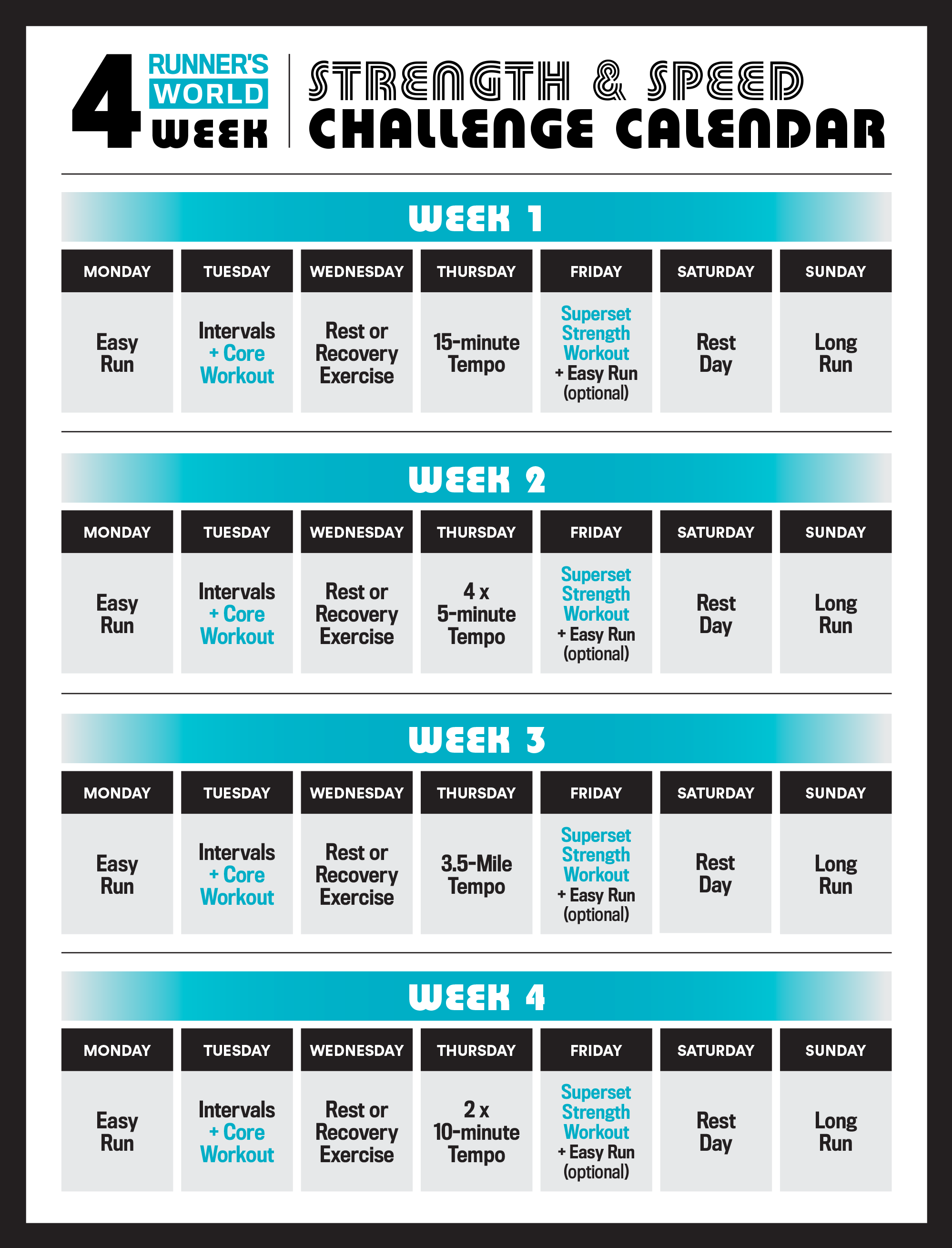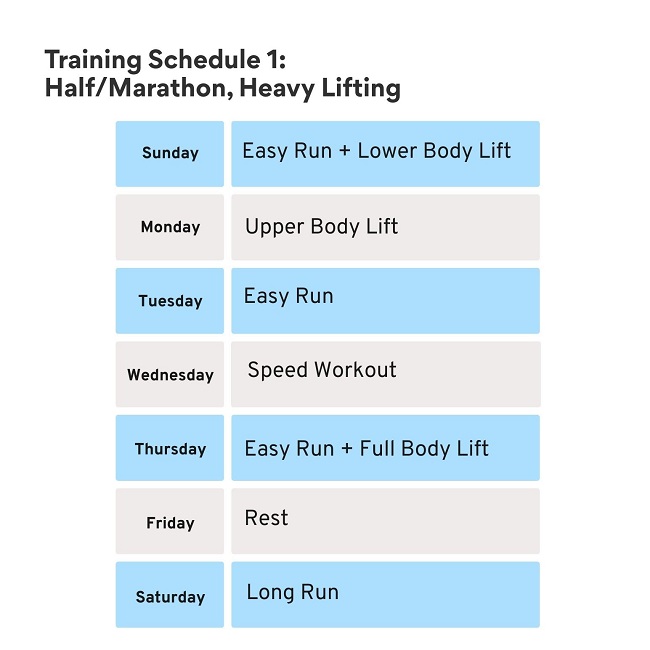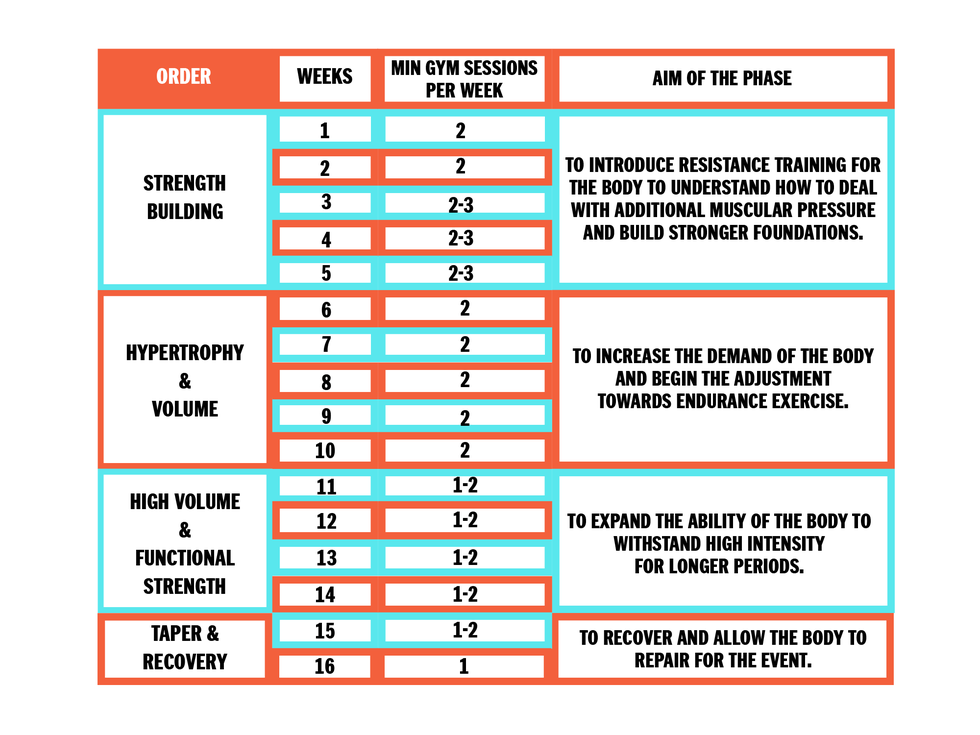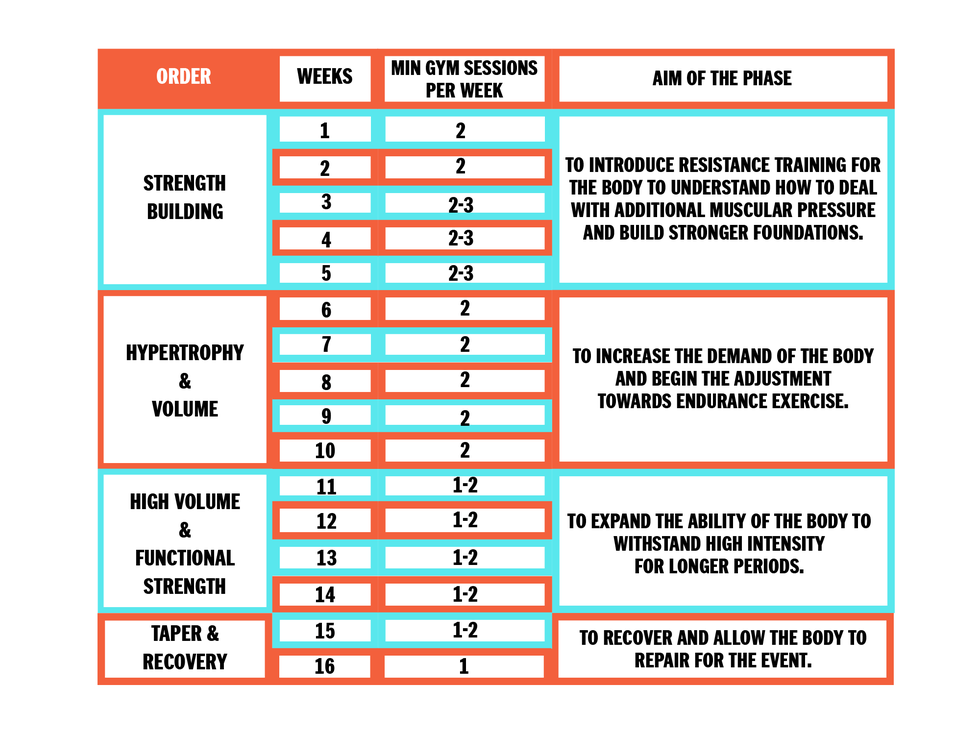A balanced running and strength training schedule boosts fitness and prevents injuries. Consistency and proper planning are crucial.
Combining running with strength training enhances overall performance and health. Runners benefit from stronger muscles, improved endurance, and reduced risk of injuries. Strength training supports muscle growth, stability, and joint protection. A well-rounded routine includes multiple weekly sessions dedicated to both disciplines.
Start with three running days and two strength training days. Gradually increase intensity and duration to avoid burnout. Ensure proper warm-ups and cool-downs to maintain flexibility. Consistency and listening to your body are key. This balanced approach leads to better results, keeps workouts enjoyable, and promotes long-term fitness.

Credit: www.runnersworld.com
Introduction To Running And Strength Training
Running improves your cardiovascular health. It helps you build stamina and endurance. Strength training makes your muscles stronger. It helps you lift heavy things easily. Combining both makes you fit and strong. This reduces the risk of injuries. You will feel more energetic every day. Your overall health will improve. You will also sleep better. Your body will become balanced. You will enjoy your workouts more.
Make sure to alternate your workouts. Do not do the same exercise every day. Run one day and lift weights the next. Always warm up before starting. This will prepare your muscles. Cool down after finishing. This helps your body recover. Eat healthy foods to fuel your body. Drink enough water to stay hydrated. Listen to your body. Rest when you feel tired. This way, you will stay strong and healthy.
Analyzing Your Fitness Goals
Setting realistic expectations is important. Dreams are good, but goals must be doable. Start small and grow. Celebrate small wins. This keeps you motivated. Never push your body too hard. Injuries will slow you down. Balance is key. Always listen to your body.
Personalizing your fitness plan is crucial. Everyone is different. Some love running; others prefer weights. Find what you enjoy. This makes the journey fun. Mix running and strength training. This keeps things exciting. Track your progress. Adjust your plan as needed. Stay flexible. Your body will thank you.
Weekly Schedule Breakdown
Running and strength training are important. Running days should be spread out. Strength days should be balanced too. This helps in avoiding injuries. A good schedule includes both activities. Keep running days and strength days separate. This allows muscles to recover properly. Running builds stamina. Strength training builds muscles. Combining both gives the best results.
Rest and recovery are key. Muscles need time to heal. Rest days are as important as workout days. Include at least one rest day in your schedule. This prevents overtraining and injuries. Sleep well and hydrate. Listen to your body. If you feel tired, take an extra rest day. Recovery helps in better performance.

Credit: www.nourishmovelove.com
Optimizing Your Running Routine
Intervals help you run faster. You run hard for a short time. Then you rest. Tempo runs make you run at a steady pace. You go a bit slower than your fast pace. Long runs build your endurance. You run longer distances but at a slower speed.
These three types of runs improve your running efficiency. They help your body get used to different speeds and distances. Always include rest days to recover. This prevents injury and makes you stronger.
Good form is key. Keep your back straight and your arms relaxed. Breathe deeply to get more oxygen. Warm-up before you start running. This prepares your muscles. Cool down after you finish. This helps your body recover.
Strength training builds your muscles. Strong muscles support your joints. This reduces the risk of injury. Stretching keeps your muscles flexible. This improves your range of motion. Drink water to stay hydrated. Eat healthy foods to fuel your body.
Strength Training For Runners
Integrating a running and strength training schedule boosts performance and reduces injury risk. Short, targeted workouts complement endurance runs effectively.
Essential Exercises For Core And Leg Strength
Squats help build strong legs. Lunges improve balance and muscle strength. Planks strengthen the core. Leg raises target lower abs. Calf raises build calf muscles. Do these exercises two times a week. They support better running performance.
Always use proper form. This reduces the risk of injury. Start with lighter weights. Increase weight gradually as you get stronger.
Upper Body Workouts To Complement Running
Push-ups strengthen chest and arms. Pull-ups work on back muscles. Dumbbell rows target upper back. Shoulder presses improve shoulder strength. Bicep curls and tricep dips tone arms. These workouts balance your body strength.
Perform upper body exercises twice a week. Balance is key for overall fitness. Strong arms and shoulders help with running form.

Credit: www.runtothefinish.com
Nutrition And Hydration Strategies
Eating right helps boost your energy. Focus on balanced meals with carbs, proteins, and fats. Carbs give you quick energy. Proteins help build and repair muscles. Healthy fats keep you full longer. Drink water regularly to stay hydrated. Dehydration can reduce performance. Consider sports drinks for long sessions. These replace lost electrolytes. Eat a small snack before workouts. This can be a banana or yogurt. It keeps your energy up. After training, eat a meal within 30 minutes. This helps recovery.
Recovery meals help your body heal. Include protein to fix muscle damage. Carbs refill lost energy. A good meal might be chicken with rice. Add some veggies for vitamins. Hydration is crucial after workouts. Drink water or a recovery shake. This helps your muscles recover faster. Avoid junk food. It slows down recovery. Instead, choose healthy snacks. Nuts, fruits, and yogurt are great options. Proper recovery nutrition keeps you strong and ready for the next session.
Monitoring Progress And Adjusting The Schedule
Keep a workout journal. Write down the exercises you do each day. Note the distances you run and the weights you lift. Track how you feel after each session. This helps you see your progress. Celebrate small milestones. Achieving these keeps you motivated. Use apps or gadgets to make tracking easier. They can show you charts of your progress.
Change your plan if you feel pain or discomfort. Listen to your body. Rest if needed. Adjust the schedule if you reach a plateau. Add new exercises or increase intensity. Modify workouts if you have new goals. For example, train for a race or build more muscle. Stay flexible with your training plan. Make changes to keep it fun and challenging.
Common Pitfalls To Avoid
Overtraining can lead to serious injuries. Rest is just as important as training. Muscles need time to recover and grow. Ignoring rest days can cause burnout. Injuries like stress fractures are common with overtraining. Listen to your body. If you feel pain, take a break. Regular stretching can also help prevent injuries. Make sure to warm up before workouts. Cooling down is equally important.
Training intensity and volume should be balanced. Too much intensity can lead to fatigue. Too much volume can cause overuse injuries. Mix high and low-intensity workouts. This keeps your body guessing and prevents plateaus. Include both short and long runs in your schedule. Strength training should focus on different muscle groups. Avoid working the same muscles two days in a row. This ensures balanced muscle development.
Supplementary Activities And Cross-training
Yoga helps improve flexibility and balance. Stretching can reduce the risk of injury. Both activities aid in muscle recovery. Try to include yoga sessions twice a week. Spend at least 10 minutes stretching after each workout. Focus on major muscle groups like hamstrings and calves. Use a yoga mat for better comfort. Consistent practice will improve your overall performance.
Cross-training adds variety to your routine. It prevents boredom and reduces the risk of injury. Here are some options:
- Cycling – Good for cardiovascular health.
- Swimming – Low-impact exercise for full-body workout.
- Rowing – Strengthens upper body muscles.
- Hiking – Great for endurance and leg strength.
Choose activities you enjoy. Aim for at least one cross-training session per week. This will help keep your workouts exciting and balanced.
Frequently Asked Questions
How Many Times A Week Should A Runner Strength Train?
Runners should strength train 2-3 times a week. This helps improve performance and reduces injury risk. Balance is key.
Can You Mix Running And Strength Training?
Yes, you can mix running and strength training. Combining both improves overall fitness, boosts metabolism, and prevents injuries.
Can You Run And Strength Train On The Same Day?
Yes, you can run and strength train on the same day. Combine both for balanced fitness and improved overall performance. Ensure proper rest and nutrition.
How To Schedule Strength Training And Running?
Alternate strength training and running days. Prioritize rest and recovery. Combine lighter runs on strength training days. Avoid intense workouts back-to-back. Listen to your body.
What Is The Best Running Schedule?
A balanced schedule includes 3-4 runs per week. Alternate easy and long runs with rest days.
How Often Should I Do Strength Training?
Aim for strength training 2-3 times a week. Ensure you target all major muscle groups.
Can I Run And Lift Weights On The Same Day?
Yes, but space them out. Run in the morning and lift weights in the evening for best results.
Should I Run Before Or After Strength Training?
It depends on your goals. Run first for endurance, lift first for strength gains.
What Are The Benefits Of Combining Running And Strength Training?
Combining both improves overall fitness. It boosts endurance, strength, and reduces injury risk.
How Long Should My Strength Training Sessions Be?
Keep sessions between 30-60 minutes. Focus on quality over quantity for best results.
Conclusion
Crafting a balanced running and strength training schedule is key to achieving your fitness goals. Consistency is crucial. Listen to your body and adjust as needed. Combining both forms of exercise leads to improved performance and overall health. Start small, stay committed, and watch your progress unfold.











